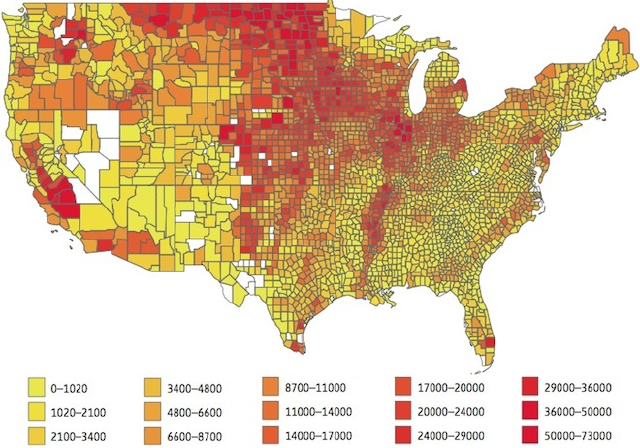Insect-eating bats are worth at least $3 billion—perhaps as much as $54 billion—per year to US agriculture alone, say biologists who evaluated their ecological contributions.
With bats threatened by careless wind-turbine development in major flyways and, more pressingly, by the new and dreadful White Nose Syndrome, protecting them isn’t just ethical. It makes bottom-line sense.
If bat mortality “continues unabated, we can expect noticeable economic losses to North American agriculture in the next four to five years,” wrote the researchers, whose study was published online March 31 by Science. “A wait-and-see approach to the issue of widespread declines of bat populations is not an option.”
The estimates are an informed, back-of-the-envelope calculation based on earlier research by study coauthor Tom Kunz, a Boston University bat specialist who in 2006 published the most detailed look ever at the relationship of bats to insects and agriculture.
In the eight-county Winter Garden region of south central Texas, Kunz’s group calculated that Mexican free-tailed bats annually saved about $740,000 in pesticide costs, or roughly $74 per acre. (The savings held steady for cotton genetically engineered to produce its own pesticides.)
The new study extrapolates those values, adjusted for local levels of agricultural productivity, to the United States at large. It’s necessarily a rough extrapolation: some regions have more bats than Texas, or fewer. And they might eat fewer insects, or more. But even as precise values vary, the underlying truth is invariable: bats eat bugs.
Their taxonomic order Chiroptera contains more species than any order except rodents, and eating insects is what they’ve evolved to do. What’s more, there are many “downstream” costs to increased pesticide use—health problems in people, accelerated development of resistance in bugs—omitted from the study.
“Our estimate is very conservative,” said Kunz. “The devil is in the details, and the devil is that this is an extrapolation of one study over the entire US. But that’s the only data we have, and we need to define this information.”

Kunz’s emphasis reflects two critical threats to bats’ future. One is the installation near bat caves and flight routes of wind turbines, which suck bats into their blades. By 2020, wind turbines will kill about 60,000 bats each year in the mid-Atlantic states alone.
The other, more immediate threat is White Nose Syndrome, an extraordinarily virulent disease that emerged in upstate New York in 2006. It had spread to 14 states and two Canadian provinces by 2010, killing well over a million bats. Those death rates are unprecedented in known mammalian history, and threaten to eliminate bats from much of North America.
Spring is the season for identifying newly infected caves, and new reports came in March from Indiana, Ohio, North Carolina, Maryland, Tennessee and New Brunswick. More are expected. Yet even as researchers dread the continued spread of White Nose, only a trickle of funding exists to investigate the disease.
The US Fish and Wildlife Service, the front-line federal protector of bats, spent about $2.4 million in 2010 on WNS. Spread across dozens of states and research teams, that money runs out fast.
Another $1.9 million specially allotted by Congress in 2010 was stripped, along with other so-called “earmarks,” from the stopgap funding resolutions that keep the US government running in the absence of an official Fiscal Year 2011 budget, which should have been passed last October.
When that budget finally passes, White Nose Syndrome research probably won’t be part of it, and agencies that support research will likely have their budgets cut. Meanwhile, whether because money is tight and competition fierce, or because of an institutional failure to appreciate the threat—or both—the National Science Foundation has barely funded WNS research.
“We get drops of water following the bucket, compared to what we need,” said Kunz. “And it’s a dry bucket now.”
One potentially promising development is the proposed Wildlife Disease Emergency Act, which would provide, at least in theory, quick-turnaround funding for research on White Nose Syndrome and other animal outbreaks. However, according to Bat Conservation International policy specialist Jocelyn Ziemian, the legislation could produce an “unfunded mandate”—creating a purse, but not putting money into it.
If bats really are worth $3 billion each year in pesticides alone, short-term frugality may ultimately prove expensive. “In terms of budget, an ounce of prevention is worth a pound of cure,” said Ziemian.
reader comments
38